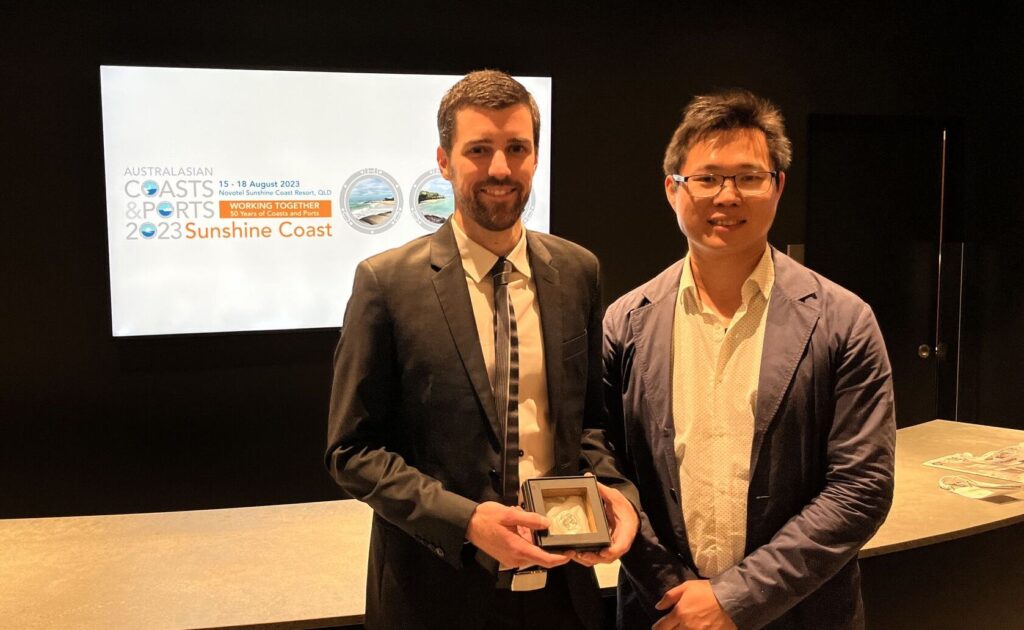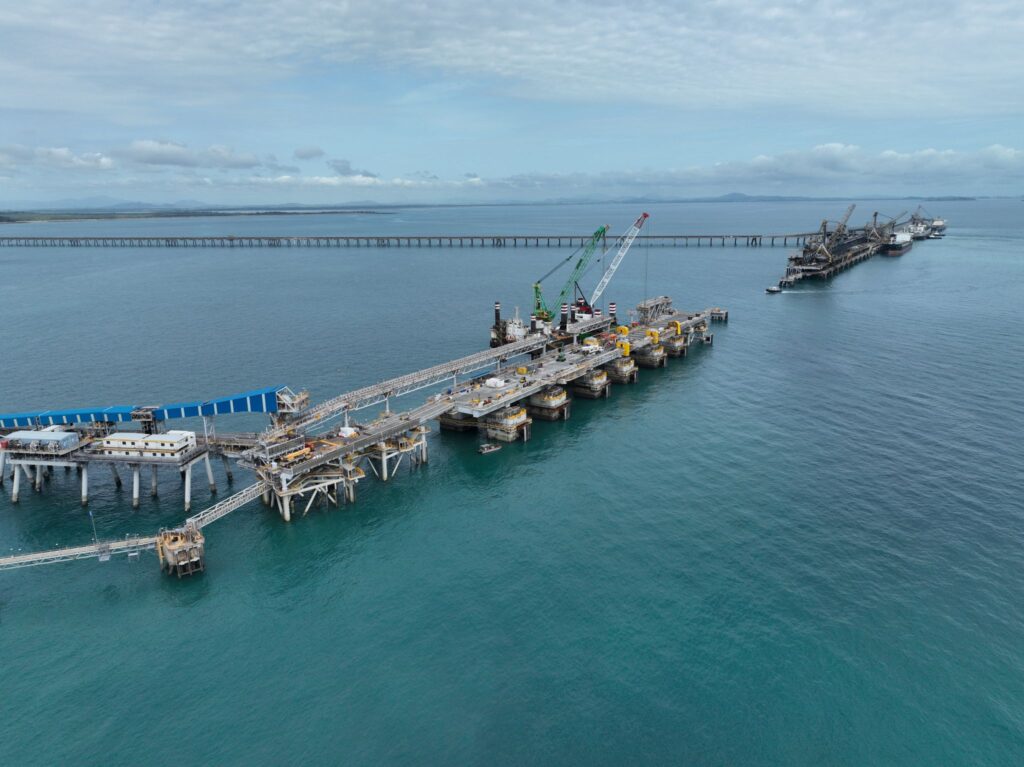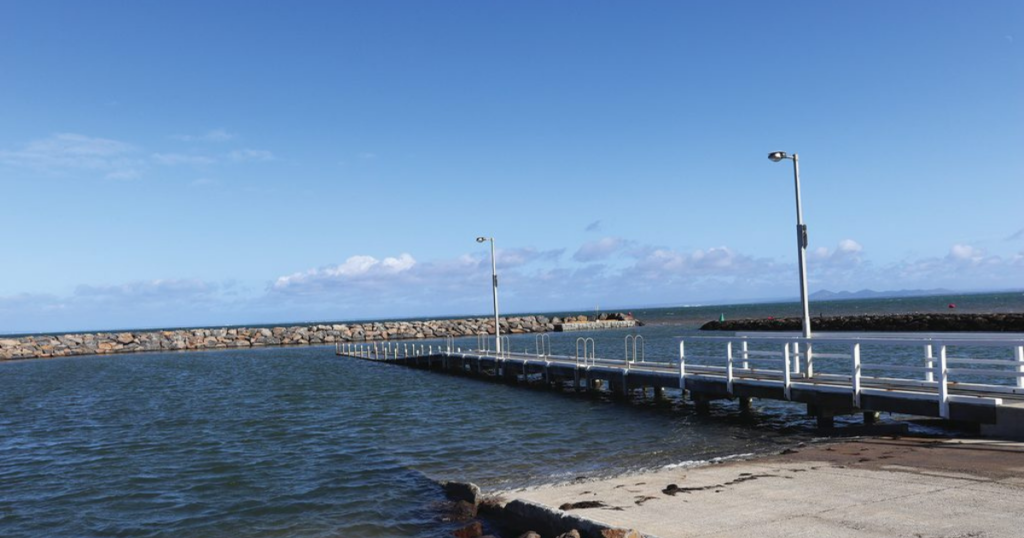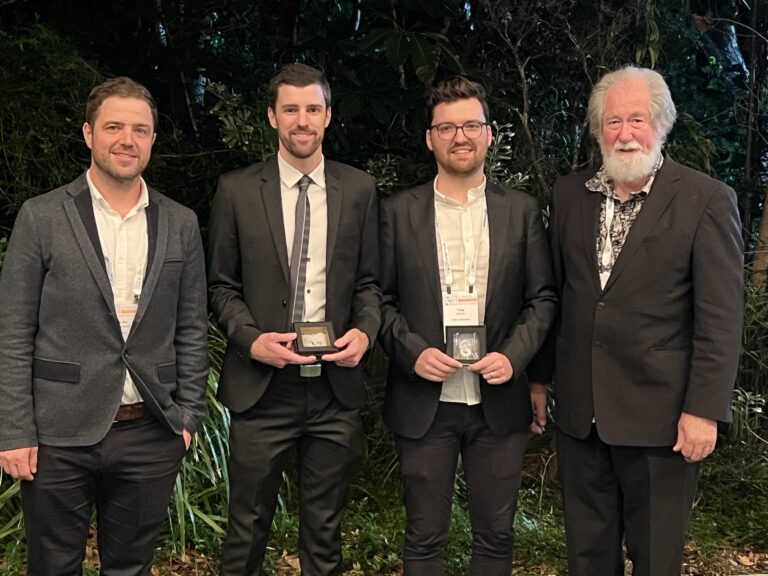The standard was so high that the judges awarded two PIANC Young Authors awards at the Australasian Coasts & Ports Conference held in August 2023 on Queensland’s Sunshine Coast.
Warm congratulations to Scott Collins and Toby Devlin who are the 2023 recipients.
Winning Papers
Scott Collins, ‘Hay Point Shiploader & Berth Replacement: a project and innovation case study.’
Toby Devlin, ‘The Point Richards rock groyne for deflecting seagrass wrack.’
Featured Image: PIANC AU-NZ Young Author Award Presentation 2023, Australasian Coasts & Ports Conference, Sunshine Coast August 2023. L-R: Luke Campbell, Chair PIANC AU-NZ, Scott Collins, Toby Devlin, A/Prof Ron Cox, PIANC Board,
Scott Collins – Hay Point Project, QLD
Scott Collins is a Technical Director in Aurecon’s Ports, Marine & Coastal team, and the Queensland Practice Lead for the ports, marine & coastal business. He has worked as an engineer and project manager with Aurecon for over 16 years on coastal, marine, port and resources projects.
The Hay Point project which Scott’s paper discussed is the shiploader and berth replacement (SABR) project for BHP Mitsubishi Alliance (BMA), at Berth 2 at Hay Point, about 40 kilometres south of Mackay.
Berth 2 was built in the 1970’s, and consists of unique large concrete caisson foundations, which support the steel superstructure, deck and shiploader. The shiploader and berth structures were approaching end of life and were also vulnerable to damage during extreme cyclones.
Scott’s award-winning paper summarised the 5+ year journey on Project SABR, from study initiation to physical model testing to innovative design elements and through to construction.
The SABR project has studied, designed and delivered a modernised and renewed Berth 2 facility with 1,000 year ARI cyclone resilience, while retaining the unique caisson foundation structures, to reliably secure the future of the berth and exports for the next 50 years.
Scott says he is proud to have been a part of project SABR – to have led a talented, innovative and dedicated engineering team over a number of years, getting to tackle and overcome some real challenges.
Scott’s paper co-author was Johnathan Kong from BHP, Brisbane (pictured below). Scott thanked ‘all the BHP/BMA team for their leadership, collaboration and support on implementing creative solutions over the journey through all project phases, and for trusting us to deliver and overcome any challenges.’
Scott’s talents and enthusiasm for PIANC and the industry may be inherited.
‘A fun fact’ Scott has informed us ‘is that my old man (Neil Collins) won the PIANC young author award back in 1990.’


Toby Devlin – Point Richards, VIC
Toby Devlin is Group Manager – Coastal and Environments VIC | Senior Engineer at Water Technology in Victoria.
Toby has considerable experience in coastal processes and modelling and has been involved in studies in all the coastal states of Australia as well as Kuwait, the United Arab Emirates, South Africa, Kenya, Cote D’Ivoire, the United States, Brazil, India, South Korea and the UK.
His domestic experience ranges from wave and sea-level models to inform coastal hazards, to sediment transport assessments for both coastal management and dredge plume environmental impacts. Aside from modelling, he has experience in studying and providing advice on coastal processes to inform management and planning of adaptation and development in the coastal zone.
Toby’s paper discussed the design and construction of the new rock groyne constructed at the Point Richards boating facility in Portarlington, Victoria.
The Point Richards ramp has been highly susceptible to sea grass build up in recent years, with the nutrient loads contributing to larger seagrass beds and northerly storm events impacting their detachment.
Seagrass beds contribute large amounts of wrack (detached leaves and stems), to their coastal – natural and built – environments predominantly during winter. Wrack is an important natural asset which serves a range of ecological functions, including nutrient recycling, the provision of food and habitat for beach fauna and, possibly, coastal protection.
Large amounts of accumulated wrack however were impacting access, usability and safety of the boat ramp at Point Richards. Management required temporary closure of boat ramp lanes, and removal of wrack using excavators and dump trucks, at an unsustainable operational expense.
A new rock groyne to the west of the boat ramp was constructed to minimise the impact of seagrass at the ramp and make maintenance dredging easier. Several concept designs were tested using particle tracking modelling to demonstrate the relative effectiveness. Due to a net longshore drift of sand to the site from both the east and west, the design also considered the management of sedimentation.
The aim is to deflect more sea grass wrack to the north of the boat ramp to limit how often the area has to be closed for removal of seagrass wrack. Authorities anticipate that dredging will still be required, with a platform at the end of the groyne designed to host a long-reach excavator to facilitate this.
Following installation of the groyne core and completion of construction in 2022, several storm events have occurred that have resulted in widespread wrack deposition. However, minimal seagrass has been observed entering the harbour, and no further seagrass wrack removal has been required from the boat ramp lanes.
Toby Devlin was Lead Author. Co-authors were Gildas Colleter from Water Technology, and Tom Gilbert from Better Boating Victoria, Melbourne.


Thanks also to:
- https://www.linkedin.com/posts/scottcollinsaurecon_proud-to-have-been-awarded-the-pianc-australia-activity-7098877203274219520-8kk5?utm_source=share&utm_medium=member_desktop
- Billy Higgins, Bellarine Times, Oct 3, 2022 Online: https://z-upload.facebook.com/bellarinetimes/posts/5279892255462115
- Seagrass wrack dynamics in Geographe Bay, Western Australia Synopsis https://www.transport.wa.gov.au/mediaFiles/projects/PROJ-R-PortGeo-SeagrassWrack-Synopsis.pdf
https://getfished.fish/vic/portarlington/point-richards
